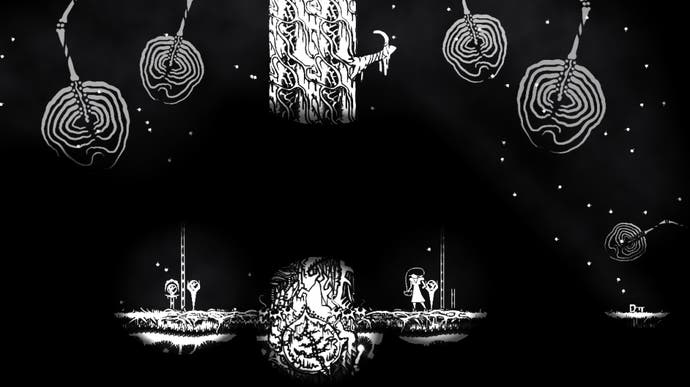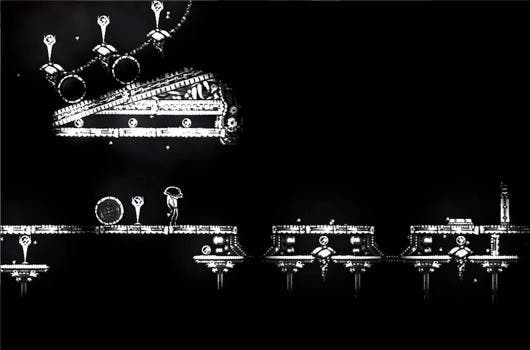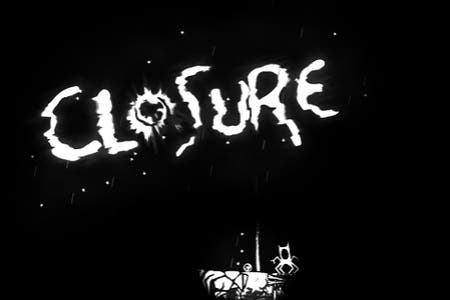Closure Review
Of light and darkness.
Closure launched today on Steam. This is a review of the PS3 version, which was released on the PlayStation Store in North America earlier this year. There are no plans for a European PS3 release at present. The PC and Mac version supports higher resolutions and features a developer commentary and some basic mod support, but otherwise it's identical.
Speaking as a lifelong arachnophobe, I recall many a night in my youth when I'd have a hard time sleeping because there was a spider in my room. I'd keep the lights on, lie awake and observe its every move with an eagle eye. If it crawled towards the ceiling over the head of the bed I'd reposition myself at the foot. If it skittered towards that end I'd shuffle back. If it was a particularly restless bugger I'd sleep on the floor. I was a weird kid.

What I eventually grew to realize was that if I turned off the lights and hid under the blankets its presence bothered me that much less; out of sight, out of mind. Of course I knew it was still there, but the lack of visibility warranted a sliver of imaginative protection. Games aren't bound by this troublesome reality, and Closure goes one step further than my feeble "kill the lights" plan ever could - by envisioning a world where that which is in the dark ceases to exist.
Closure takes place in a monochrome world, highlighting the distinction between the tangible and the nothingness that surrounds it. The black-and-white art may bring Limbo to mind, but where Playdead's adventure cast you as a silhouette against hazy grey backgrounds, Closure inverts the two; your avatar and objects in the environment are white scratchboard etchings enveloped in a pitch black void.
Carry a glowing ball and it will illuminate your path. Drop it down a rabbit hole and it will make the ground beneath your feet vanish, causing you to fall in its wake. Reach a wall that can't be scaled and you can shine a beam at it, forming a light-based bridge through its visible region. Sometimes lanterns are on tracks that, upon activation, turn into makeshift elevators taking you through walls. Suddenly the world you knew - or thought you knew - no longer remains.
It's an ingenious system that's simple to understand but deceptively complicated, thanks to clever level design. As you can imagine, light placement is vital to surviving this grim world. Some light sources take the form of shining orbs, others lamps emitting beams on rotating pivots, and some are crystals that shine even stronger rays but need a luminous source to reflect first. Manipulating beams of light may be one of gaming's oldest, most tired tropes, yet Closure's dynamic shade-based spatial system adds a fresh spin to this well-worn cliche.

Puzzles get increasingly complex as new concepts are introduced, like plants that need to be illuminated to unlock nearby doors. Some flowers emit light but fold up like a scared turtle when you get close, and spikes line parts of the terrain, preventing you from placing glowing spheres on top of them.
At least the spikes won't kill you; you have the amorphous environment to thank for that. Given that Closure's entire premise is based on causing the player's sight and perception to deceive one another, it's very easy to make a grave mistake. Even after several hours of coming to terms with Closure's peculiar systems, I'd still instinctively grab a spotlight that was aimed downward and tilt it up to scan the room before realizing that - whoops! - I just caused the floor to disappear.
Most stages are mercifully brief and can be solved in short order once cracked, but getting to this point can take a lot of finagling. Painstakingly retracing the same several steps only to make a simple error can grate, and this is a game that would benefit from one of those nifty time-rewinding mechanics. One could argue that this more punishing design accentuates its horror trappings by emphasizing careful, meticulous play - but given the game's focus on puzzles, players are going to do that anyway, and this arcane system of constant restarts is unnecessarily frustrating.
The striking aesthetic does give Closure an eerie mood, with its rich, detailed scenery hidden in the shadows. The game spans several settings, ranging from an oppressive factory comprised of H.R. Giger-esque machinations of rubble and metal mangled into unearthly scrapheaps, to a lost forest full of twisted trees and ominous rain, or a haunted circus adorned with creepy teddy bears, tents, and cages. Despite most of the game being shrouded in darkness, Closure is a bold, stylistic piece of work.

What holds it back from achieving the same splendour as its similarly artsy puzzle-adventure brethren like Portal and Braid is its muted narrative. Where those games seamlessly integrated their puzzles in service of a larger tale, Closure seems content to relegate the latter to the sidelines. There's a hint of a story about a four-legged monster/alien/thing that wears masks of people to relive a chapter from their lives - with each act placing the player in control of a new character - but most of these tales lack a cohesive arc.
You probably shouldn't expect a puzzle game to spin a great yarn, but it would have helped if each act and the conclusion built to a greater crescendo; it might have added some much-needed oomph to the clinical procession of puzzles. Despite conquering all 82 stages, the ending felt limp and disappointing as a reward. There is evidently a "true ending" that could potentially provide a more satisfying conclusion, but it requires collecting 30 hidden moths strewn throughout the game. What am I? Made of brains?
These are still only minor issues in what is otherwise an excellent indie puzzler. Poking around Closure's elusive planes is simultaneously enchanting and worrisome, when the entire fabric of reality is dependent on twisting a bulb the right way. Closure may stop short of delivering the sort of swashbuckling adventure one might hope for from a journey through this shadowy netherworld, but it remains thoroughly enjoyable puzzle game that twists your brain in all sorts of maddening directions while keeping the answers just out of reach. It's just a shame that in the end Closure couldn't provide more, um, closure.









